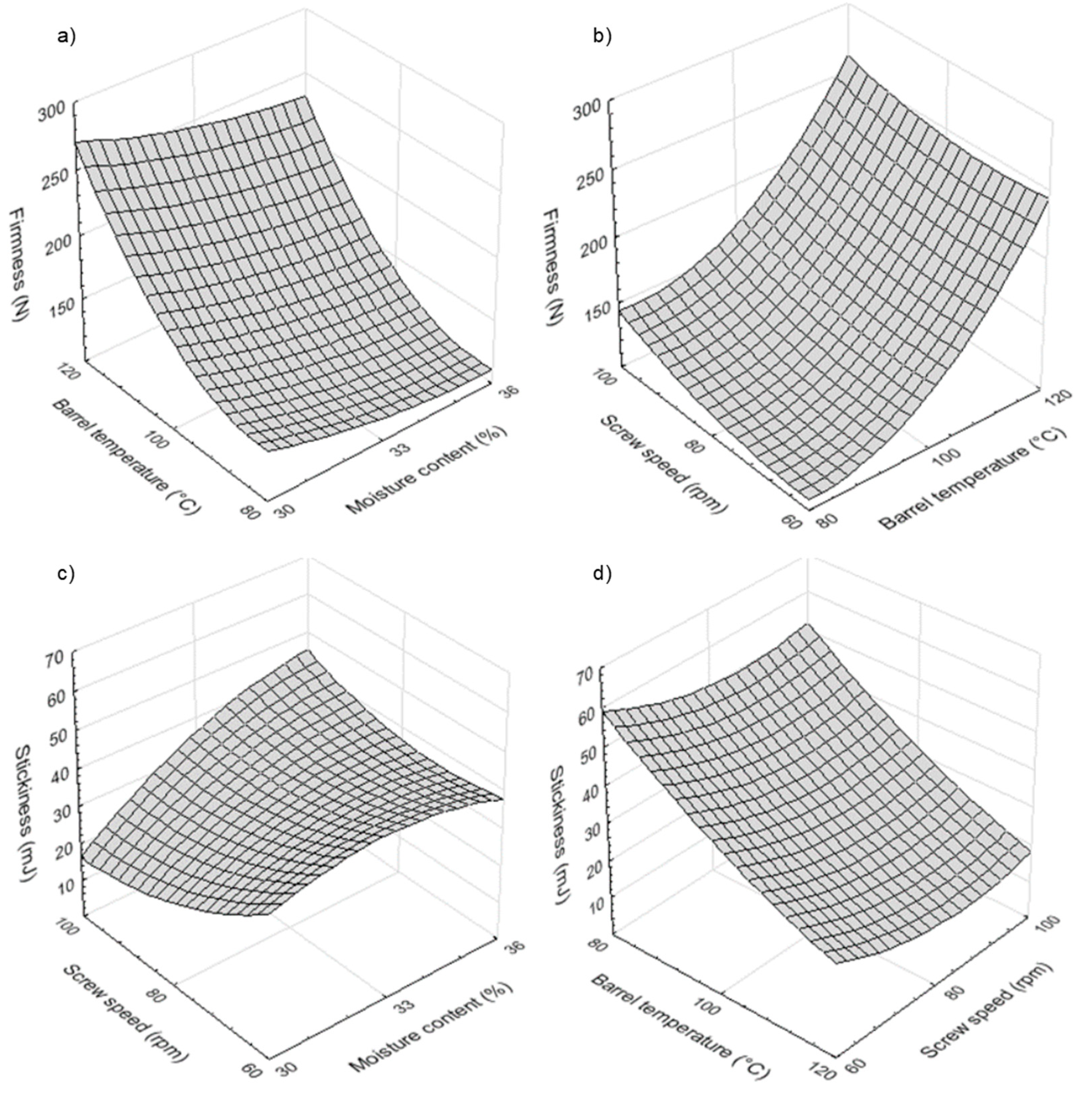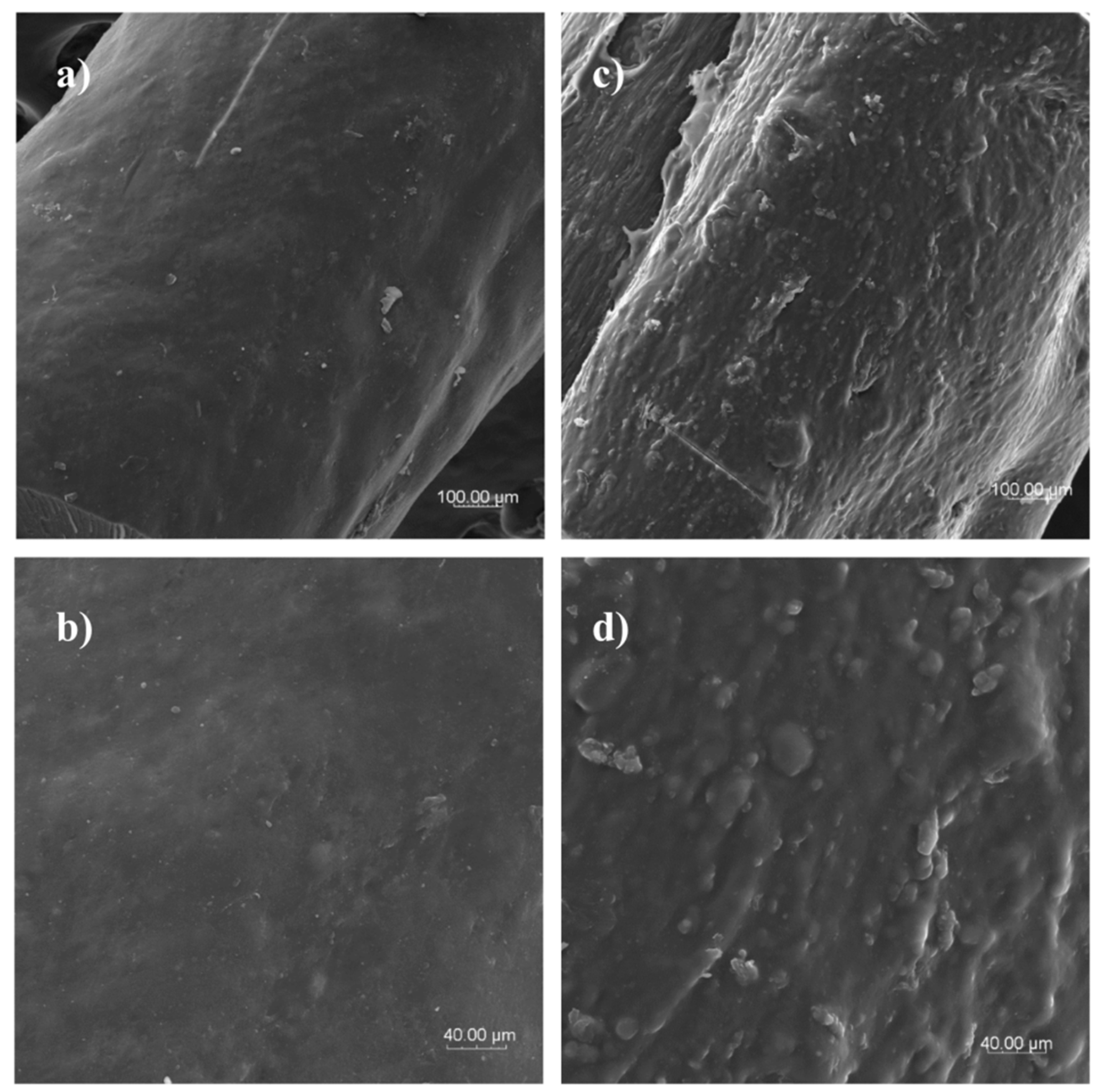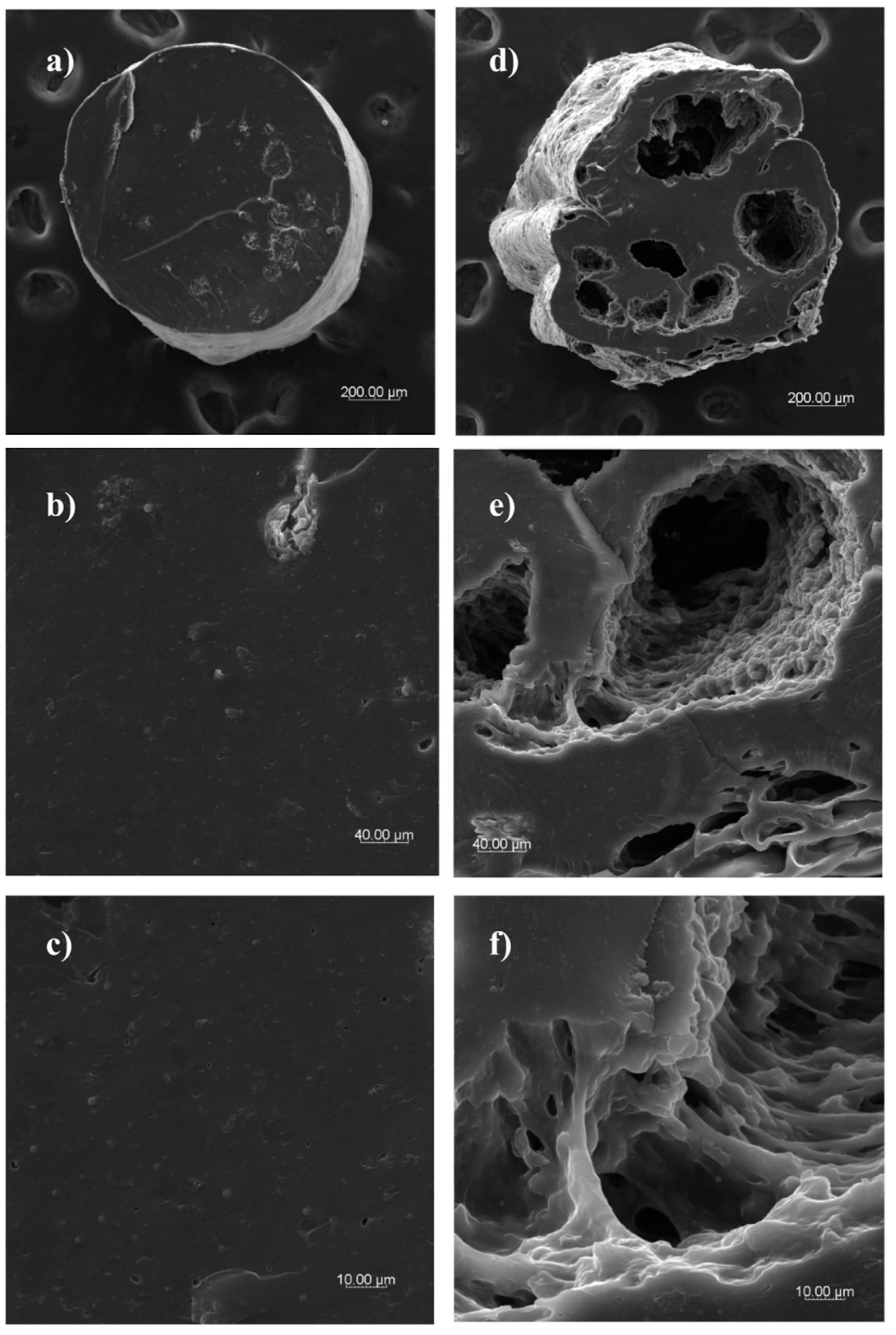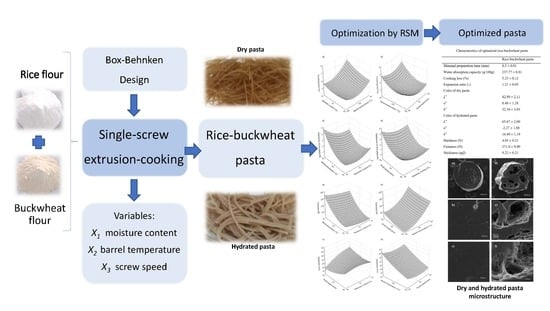3.5.1. Chemical Composition
On a dry basis, buckwheat flour was characterized by significantly higher protein (10.55%), ash (1.58%), fiber (4.57%), and TPC (1.85 mg GAE/g) contents than rice flour (7.72%, 1.37%, 1.31%, and 0.04 mg GAE/g respectively) (
Table 4). Bouasla et al. reported similar observations for rice-buckwheat pasta composition (protein 9.78%, ash 1.07%, and fiber 5.21%) if compared to rice pasta (protein 8.25%; ash 0.50%, and fiber 3.21%) [
21]. The high amount of fiber recorded in rice-buckwheat pasta would be beneficial for persons with celiac disease since, as noted by Stojceska et al. [
29], they have low dietary fiber intake. The increased fiber in extruded products could be due to the effect of insoluble fibrous fractions being created because of the transformations occurring during the extrusion-cooking, which may have an effect on the formation of resistant starch [
30].
In our experiment, incorporation of buckwheat flour led to an increase of TPC in rice-buckwheat pasta (0.40 mg GAE/g) 10 times more than that of rice flour (0.04 mg GAE/g). Phenolic acids (especially of protocatechuic acid and the cinnamic series) and flavonoids (especially quercetin and rutin) make up most of the polyphenol classes found in buckwheat [
31]. The extent and the mechanism of the protective action of phenolic compounds is due to their anti-inflammatory, anticarcinogenic, antibacterial, and antiviral activity in the human body, as well as their high antioxidant capacity [
18,
32]. Therefore, the presence of phenolic compounds in gluten-free pasta would also be beneficial for persons with celiac disease.
In addition, very low-fat content (0.16%) has been noticed for rice-buckwheat pasta, as compared to the separate raw materials (2.30% and 2.04% for rice flour and buckwheat flour, respectively). Similar observations have been reported for wheat-based and rice-based pasta manufactured by extrusion-cooking [
20,
21]. This phenomenon is related to the formation of amylose-lipids complexes during pasta processing by extrusion-cooking, causing a decrease in lipids extractability [
33].
3.5.2. Cooking, Physical, and Textural Properties of Rice-Buckwheat Pasta
Table 5 shows the characteristics of rice-buckwheat pasta produced at the optimal processing parameters, in comparison to rice pasta, as reported in our previous study [
21].
Hot water hydration for 8.5 min was sufficient for rice-buckwheat pasta to have the proper consistency. This differs from conventional cooking. The comparison of our results with previous studies using the same method of hydration in hot water revealed that rice-buckwheat pasta had a MPT slightly higher than the time reported by Bouasla et al. [
21] for rice pasta (8 min) and much higher than reported by Wójtowicz and Mościcki [
20] for common wheat pasta (5.5 min).
Water absorption capacity of rice-buckwheat pasta (237.77 g/100g) was also significantly higher than that reported for rice pasta (181.53 g/100 g). This effect could be explained by the higher water-binding capacity of buckwheat starch [
34], as well as by its high content of fiber, which has the ability to absorb water very efficiently. The capacity, as noted by Wójtowicz and Mościcki [
20], is, however, slightly lower than that reported for precooked common wheat pasta (260 g/100 g) and demonstrates the presence of gluten proteins.
Rice-buckwheat pasta had significantly higher CL (5.23%) than rice pasta (3.57%). This increase in CL could be related to the presence of fiber, as this weakens the starch network in both gluten-free matrices and gluten-based matrices [
21]. However, the obtained value indicated good quality of rice-buckwheat pasta, since 10% of cooking loss was reported as a quality limit for pasta [
35]. Our work shows that the structure of precooked products was able to preserve the pasta integrity during hot water hydration and, therefore, to minimize cooking loss. Indeed, during extrusion-cooking, heat, mechanical shearing, and pressure contributed in the formation of a homogenous and compact starch-protein matrix. This was confirmed by the pasta microstructure assessment (Figure 5c). Similar findings have been reported for gluten-free pasta in previous studies [
11,
20,
21]. In addition, Vallons and Arendt [
36] reported that pressure-thermal treatment makes buckwheat starch granules more resistant to swelling and disintegration under the influence of additional heat, due to the gelatinization of buckwheat starch between 70 and 75 °C.
Our work showed that the expansion ratio of rice-buckwheat pasta (1.21) was significantly lower than that of rice pasta (1.55). This may be due to the low amount of total starch and high amount of protein and fiber in buckwheat flour, which limits the expansion of pasta products [
21]. The increase of dough viscosity inside the extruder barrel induced by the increase of protein and fiber content involves longer residence time and higher mechanical shearing forces, which may cause a higher extent of starch molecular degradation, leading to a low expansion ratio [
27]. Yet, as observed by Wójtowicz and Mościcki [
37], the effect of high fiber content on extrudates may also limit the expansion of extruded products for common wheat pasta supplemented with bran addition or breakfast cereals based on wholegrain wheat flour [
38].
Pasta color is considered an essential parameter for evaluating pasta quality [
39]. Both dry and hydrated pasta products contain buckwheat flour. This is characterized as having lower lightness, less green tint, and more intensive yellowness than rice pasta (
Table 3). These results can be related to the darker color and the presence of carotenoid pigments in buckwheat flour.
Dry rice-buckwheat pasta showed significant lower hardness (4.05 N) than rice pasta (12.12 N). This effect could be related to the lower diameter of rice-buckwheat pasta, compared to rice pasta, and to the presence of fiber fractions from buckwheat flour. These fiber fractions could weaken pasta structure by the formation of discontinuities or cracks inside the pasta strand [
39].
Adding buckwheat flour into the pasta recipe increased the firmness of the hydrated pasta. Firmness values differed significantly, with values of 199.5 N for rice pasta and 271.0 N for rice-buckwheat pasta. This can be explained by the higher protein content in rice-buckwheat pasta, compared to rice pasta and the formation of more firm structure after hot water hydration.
The incorporation of buckwheat flour increased significantly the stickiness of hydrated pasta (2.48 mJ and 9.22 mJ for rice pasta and rice-buckwheat pasta, respectively). This increase in pasta stickiness could be the result of higher fiber content and/or higher amount of compounds leached from the surface of rice-buckwheat pasta during hot water hydration, as confirmed by higher cooking loss compared to rice pasta. Alamprese et al. [
7] showed that replacement of wheat flour by buckwheat in lasagna had an effect on lower break load and break strain values of cooked products if the amount of buckwheat flour in the recipe increased.
3.5.3. Sensory Attributes
For all of the sensory attributes of hydrated pasta, rice-buckwheat products received higher scores than rice pasta (
Table 6). When appearance, color, flavor, taste, and stickiness were evaluated in a 5-point scale, all the results were above 4.0 for rice-buckwheat pasta. This indicates that the optimized pasta is of very good quality. Moreover, while the results of stickiness performed by an instrumental assessment were higher for rice-buckwheat pasta, in a sensory test, consumers did not confirm the higher stickiness of supplemented pasta, because the specific taste and consistency of rice-buckwheat pasta and increased stickiness had no negative effect on sensory feelings. In addition, for overall acceptability, and utilizing a 9-point hedonic scale, rice-buckwheat pasta received higher scores (7.27) than rice pasta (6.53).
The replacement of 50% of starchy components by pseudo-cereals such as buckwheat in bread [
4] or 25% of a recipe in gluten-free pasta [
40] can improve nutrients content, including proteins and minerals (calcium, magnesium, zinc, and iron). Our work and previous studies show that application of buckwheat flour has no negative effect on the sensory profile, especially for pasta surface smoothness, odor, and overall acceptability [
40]. Moreover, beyond enhanced nutritional value, buckwheat also has a specific taste that can have a positive effect on the sensory profile of gluten-free products. This notion is confirmed by our results.
3.5.4. Microstructure
The microstructure of dry and hydrated optimum rice-buckwheat pasta was observed with a scanning electron microscopy. Herein, dry rice-buckwheat pasta demonstrated a smooth surface (
Figure 4a,b). After hydration in hot water, the surface of pasta presented a slightly rough surface probably due to the leaching of unbounded compounds to hot water from the pasta surface (
Figure 4c). At high magnification, the surface of pasta highlighted the presence of melted materials (
Figure 4d). When the processing temperature of optimum rice-buckwheat pasta was found to be 120 °C, with the initial moisture of 30% and screw speed at 80 rpm during processing, a proper and stable structure was formed, both for the surface (
Figure 4b) and cross-section (
Figure 5c) of the dry pasta. This compact structure was reached due to the integrated effect of heating and shearing of rice-buckwheat blends during extrusion-cooking [
10]. Past studies reinforce this notion. Vallons and Arendt [
36] undertook SEM imaging for pressure-thermal treated buckwheat starch and showed a complete breakdown of the granular structure after treatment above 65 °C, with the starch concentration in a treated solution being 25%.
A homogenous and compact inside structure was noted during the observation of the cross-sectional microstructure of dry pasta (
Figure 5a–c). This structure is due to the effect of extrusion-cooking conditions (moisture, high temperature, and mechanical shearing forces). This induces starch gelatinization and retrogradation, and, thus, a coherent structure [
11,
12,
21]. Under high magnification (
Figure 5b), only a few starch granules were observed; these were surrounded by a melted uniform matrix formed as a result of starch gelatinization during processing. The cross-section of hydrated pasta is characterized by compact structure with visible empty spaces inside the pasta tread that resulted from the leaching of components during hot water hydration. Moreover, under high magnification, the external parts of the pasta show a partly porous structure that is due to migration of hot water inside pasta (
Figure 5d). Such effect supports the low values of cooking loss found in this study. Hydrated optimum rice-buckwheat pasta observed at high magnification (
Figure 5e,f) showed diversified internal structure based on the visible homogenous matrix, with several spaces filled with a melted starch-protein matrix, with long bounded complexes keeping the structure compact when the pasta underwent hot water hydration. This was confirmed by the high firmness results of the tested pasta.











